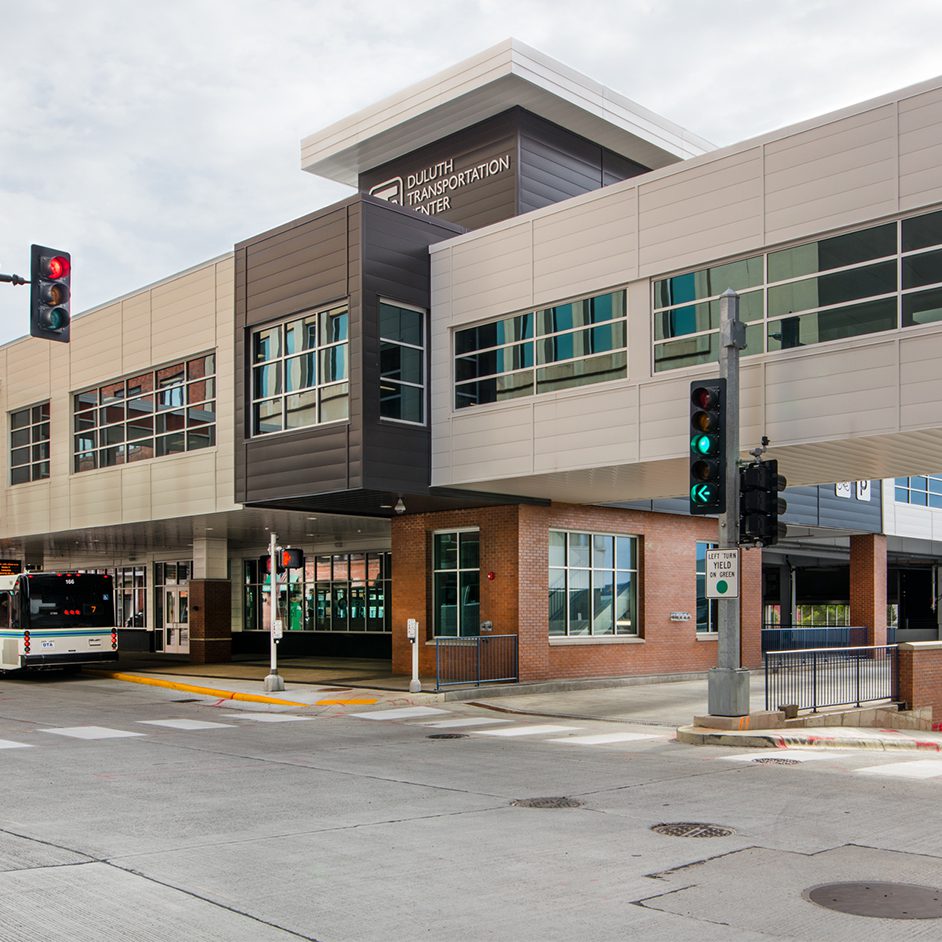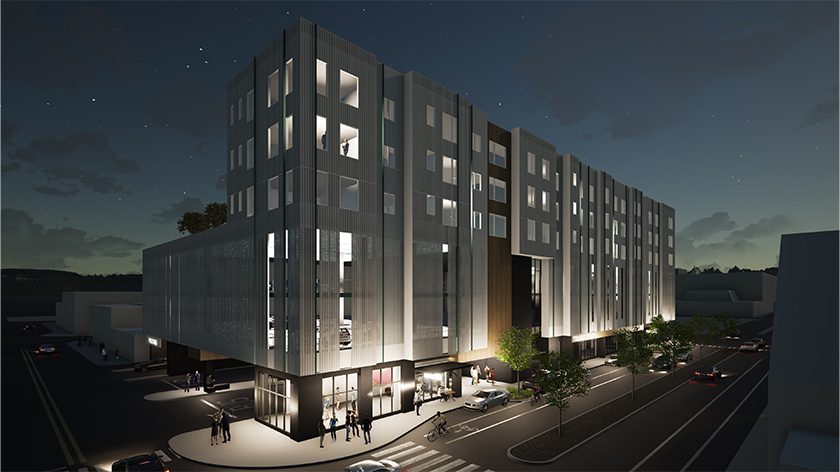
Midsized cities are increasingly investing in public transit centers. Their goals vary, of course. Most want to improve the overall passenger experience and make ridership more attractive. Some wish to broaden the reach of city services, while others hope to reduce congestion in high-traffic areas. Others are motivated by a desire to shrink their city-wide carbon footprint.
LHB’s ongoing work in Duluth, Eau Claire, and Appleton has given our design team unique insights into the transit challenges and needs of Midwestern communities. We’ve grown to understand how comfort, security, weather, and downtown revitalization shape transit center design. Over time, what we have learned about these building types has evolved into a set of best practices. In our work with clients, here are four things our design team recommends to clients eager to create high-functioning transit centers.
Prioritize Comfort and Protection for Riders
Riders changing buses in downtown Duluth had to cross a busy street prior to the opening of the Duluth Transportation Center. Buses mixing with cars, pedestrians, and bikes made public safety a major concern. Accessibility to the extensive Duluth Skywalk system was also difficult and confusing for the many visitors in the region’s tourism industry.
The new transit center, completed in 2016 for the Duluth Transit Authority (DTA), features a temperature-controlled waiting area directly connected to the Skywalk with seating and windows that allow riders to monitor each bus’s arrival while never crossing a traffic lane. The long linear layout provides visual access to a DTA service desk, a police substation, and buses that provide private regional service.
At the Eau Claire Transit Bus Transfer Center, buses pull inside, allowing passengers to board without ever setting foot outside the building. The arrangement will be the same in Appleton, where passengers will also have immediate access to real-time passenger information, ticketing machines, phone charging stations, and places to safely store bikes.

Consider Connectivity to Other Forms of Transit
Buses almost never deliver passengers from their front door to their final destination. Most riders use other forms of transit to complete their journey — a “last mile” that may be a quick walk, a brief bike ride, or a short drive. That is one reason why the Duluth Transportation Center includes connections to the city’s skyway for pedestrians, and hourly and contract parking for vehicle owners. The center incorporates a taxi stand and places to lock up bikes. Its location near railroad tracks offers the option to connect with future passenger-train service.
Bikes are a common way to augment bus journeys, so the DTA design features roll-up ramps on stairways, fix-it repair stations, safe and secure storage racks, and extra space in the passenger loading areas that allow cyclists to mount their bikes on the front of a bus.
Instill a Sense of Safety and Security
People can feel intimidated by public spaces. Creating a sense of safety, security, and welcome is a priority in designing transit centers. Visibility can be enhanced with good lighting, which reduces shady business in dark corners, and the use of glass in elevators, which makes them seem safer. Typically, restrooms with open entryways feel safer—and are more accessible—than restrooms with doors that close. The Duluth Transit Center also features a police substation, which discourages bad behavior on the premises.
Add Value with Housing and Commercial Spaces
Many municipalities view investments in transit centers as ways to rejuvenate downtown areas or other urban hubs. Existing infrastructure reduces the overall cost of connections, and transit helps boost foot traffic past existing restaurants, retail, and entertainment venues.
When the Eau Claire Transit Bus Transfer Center is complete, the building will include ground-floor commercial space, two levels of parking, and three stories of apartment housing. Mixed-use developments like these create dynamic hubs for shopping, living, and recreation. Residents have easy access to public transit, reducing their reliance on individual vehicles, and transit users can take advantage of on-site services and commerce.
In Appleton, the proposed transit hub is located adjacent to the central public library, a popular destination, and a parking structure. City officials see the new center as a key component to a wider neighborhood revitalization.
Interested in learning more about LHB’s transit projects? Read about our work for Metro Transit. ■


